Streak plate method - Study guides, Class notes & Summaries
Looking for the best study guides, study notes and summaries about Streak plate method? On this page you'll find 186 study documents about Streak plate method.
Page 3 out of 186 results
Sort by

-
Microbiology Lab Quiz 1 with Complete Solutions
- Exam (elaborations) • 8 pages • 2024
- Available in package deal
-
- $8.99
- + learn more
Microbiology Lab Quiz 1 with Complete Solutions ocular lens demagnifies the image formed by the objective lens body tube transmits the image from the objective lens to the ocular lens objective lenses primary lenses that magnify the specimen mechanical stage holds the microscope slide condenser focuses light through specimen diaphragm controls the amount of light entering the condenser illuminator light source fine focusing knob used for focusing the specimen; turning the know changes the...
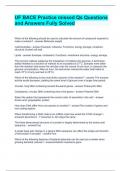
-
UF BACE Practice missed Qs Questions and Answers Fully Solved
- Exam (elaborations) • 6 pages • 2024
-
Available in package deal
-
- $15.49
- + learn more
UF BACE Practice missed Qs Questions and Answers Fully Solved Which of the following should be used to calculate the amount of compound required to make a solution? Molecular weight Carbohydrates Example: cellulose. Functions: energy storage, receptors, structure of plant cell wall. Lipids Example: cholesterol. Functions: membrane structure, energy storage. The enzyme maltase catalyzes the break down of maltose into glucose. A technician added maltase to a solution of ma...
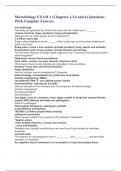
-
Microbiology EXAM 1 (Chapters 1,3,4 and 6) Questions With Complete Answers.
- Exam (elaborations) • 17 pages • 2024
-
- $13.99
- + learn more
Microbiology EXAM 1 (Chapters 1,3,4 and 6) Questions With Complete Answers. microobiology The study of organisms too small to be seen with the naked eye is _______ viruses, bacteria, algae, protozoa, fungi and helminths What are the six major groups of microorganisms? 3.5 billion years ago Single celled organisms arose ______ million years ago and have been shaping our earth ever since Eukaryotes = have a true nucleus (include protozoa, fungi, plants and animals) Prokaryotes= lack a tr...
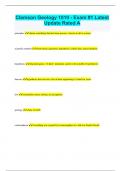
-
Clemson Geology 1010 - Exam #1 Latest Update Rated A
- Exam (elaborations) • 16 pages • 2024
- Available in package deal
-
- $9.99
- + learn more
Clemson Geology 1010 - Exam #1 Latest Update Rated A principles claims something that has been proven - known to all as correct scientific method observation, questions, hypothesis, collect data, and evaluation hypothesis educated guess; "if-then" statement. needs to be testable; be predictive theories hypothesis but now has a lot of data supporting it; tested for years law essentially correct (always an exception) geology study of earth catastrophism everything was caused by 6 catastrop...

-
MCB 2610 Lab Practical Exam 2024
- Exam (elaborations) • 7 pages • 2024
-
- $13.99
- + learn more
What is the process of contamination control? - Aseptic technique What are pipettes - calibrated glass tubes used to measure and dispense small volumes of liquids What color is the bigger vs. smaller micropipettors pipettes? - Green - bigger Blue - smaller What is the purpose of isolating bacteria? - To establish a PURE CULTURE, to be able to study to study the physiology and morphology of a particular bacterial type What is the quickest and most economical method of bacterial isola...
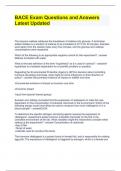
-
BACE Exam Questions and Answers Latest Updated
- Exam (elaborations) • 3 pages • 2024
-
Available in package deal
-
- $14.49
- + learn more
BACE Exam Questions and Answers Latest Updated The enzyme maltase catalyzes the break down of maltose into glucose. A technician added maltase to a solution of maltose to be incubated at 37°C for 20 minutes. Samples were taken from the reaction tube every five minutes, and the glucose and maltose concentrations were measured. Which of the following is an appropriate negative control for this experiment? Maltose incubated with water What is the best definition of the term "hypothesi...

-
BIOD 171 lab exams 1-9 (GRADED A) Questions and Answer solutions | Portage Learning
- Exam (elaborations) • 22 pages • 2022
-
- $11.49
- 1x sold
- + learn more
BIOD 171 lab exams 1-9 LAB 1 Answer the following questions 1. What three elements are used in an autoclave to sterilize equipment? heat, pressure, and steam 2. What is the minimum temp erature an autoclave must be set at to achieve sterile condition? 125°C 3. If you are working in a lab in which an autoclave is not available, and you are pressed for time, which would you chose to best sterilize your equipment? Hot steam or hot air? Explain why you chose your answer. Hot steam is the best choic...

-
BIOS 242 Week 4 Assignment; Lab 8 of 14 Onsite; Fomite Transmission.
- Other • 2 pages • 2024
-
- $8.99
- + learn more
BIOS 242 Week 4 Assignment; Lab 8 of 14 Onsite; Fomite Transmission Learning Objectives: Define fomite and how bacteria are transferred via fomites. Explain the role of fomite transmission in the hospital. Define nosocomial infections, HAIs (hospital acquired infections), and Iatrogenic infections. Introduction: Materials: Agar plate, Marker, ruler, sterile swabs Method: Obtain one nutrient agar and divide the back of the plate into 8 sections using ruler and marker. Label ...

-
Microbiology EXAM 1 (Chapters 1,3,4 and 6) Questions With Complete Answers.
- Exam (elaborations) • 17 pages • 2024
-
- $14.49
- + learn more
Microbiology EXAM 1 (Chapters 1,3,4 and 6) Questions With Complete Answers. microobiology The study of organisms too small to be seen with the naked eye is _______ viruses, bacteria, algae, protozoa, fungi and helminths What are the six major groups of microorganisms? 3.5 billion years ago Single celled organisms arose ______ million years ago and have been shaping our earth ever since Eukaryotes = have a true nucleus (include protozoa, fungi, plants and animals) Prokaryotes= lack a tr...
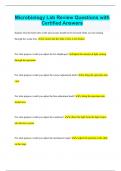
-
Microbiology Lab Review Questions with Certified Answers
- Exam (elaborations) • 16 pages • 2024
- Available in package deal
-
- $9.99
- + learn more
Microbiology Lab Review Questions with Certified Answers Explain why the body tube of the microscope should not be lowered while you are looking through the ocular lens. to ensure that the slide or lens is not broken For what purpose would you adjust the Iris diaphragm? adjust the amount of light coming through the specimen For what purpose would you adjust the course-adjustment knob? to bring the specimen into view For what purpose would you adjust the fine adjustment knob? to bring the spe...

How much did you already spend on Stuvia? Imagine there are plenty more of you out there paying for study notes, but this time YOU are the seller. Ka-ching! Discover all about earning on Stuvia


